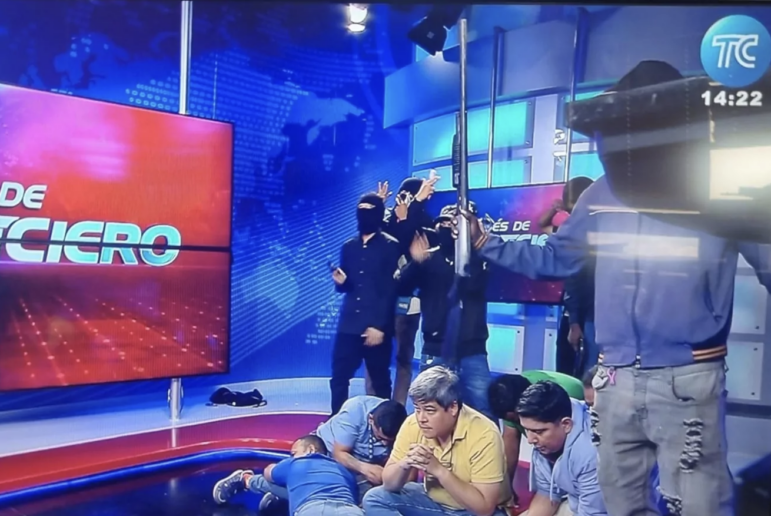

The coronavirus outbreak has pushed journalists to try new tools and ideas. Photo: Edward Jenner/Pexels
Lessons on Reporting COVID-19 from Spain, Italy, and Ecuador
Like all professions, investigative journalism has had to adapt to the realities imposed by the COVID-19 pandemic. Around the world, newsrooms are responding to basic challenges, such as social distancing while reporting.
Reporters are often expected to help audiences better understand various types of information, including the imminent economic crisis and the ongoing decrees and regulations that governments have been rolling out during the pandemic. At the same time, editors are have to be conscious about the mental health impact the crisis is having on their journalists.
At a recent Spanish-language webinar, Periodismo de investigación en tiempos de pandemia, the Global Investigative Journalism Network (GIJN) and the Instituto Prensa y Sociedad (IPYS) invited journalists from some of the countries most affected by the pandemic to share what they’ve learned during this process. Isabela Ponce (GK, Ecuador), Eva Belmonte (Civio, Spain), Cecilia Anesi and Giulio Rubino (both from the Investigative Reporting Project Italy), talked about their experiences and took questions from hundreds of journalists around the world.
Adapting to COVID-19
When the COVID-19 crisis hit, the Investigative Reporting Project Italy (IRPI) put stories that required reporting outside the newsroom on hold while they discussed how to approach the pandemic. Taking photographs or doing live coverage didn’t make sense, because they weren’t a breaking news outlet. Also, IRPI didn’t work on health issues and they weren’t science journalists. Their answer was to focus on investigative journalism on the topics surrounding COVID-19, and specifically, about the economic and social crisis created by the virus.
“We took on the topics in which we had the most experience, like government contract corruption, because we know that during states of emergency a lot of these problems crop up,” said IRPI’s Anesi. They wrote about how in the hardest-hit part of Italy — the northern region of Lombardy — the right-leaning regional government in power for 15 years had cut investment in public health in order to promote private health companies.
Anesi’s colleague Rubino said other newsrooms would do well to concentrate on the subjects they’re most experienced with, and highlighted that for the moment the local impact is often the most interesting.
“Phase two of the lockdown shows us the importance of your direct neighbors, your neighborhood, and your city,” he said. “The first narratives about how to imagine post-COVID society take place in these local environments.”
In Ecuador, one of the hardest hit countries in Latin America, reporters at the investigative website GK said at first they needed to establish how to combine coverage of COVID-19 with their three thematic pillars: human rights, the environment, and transparency. So they needed to produce stories about, for example, mining, Indigenous communities, or women’s rights that were linked to the virus.
When the economic effects of the pandemic began to appear, GK decided this had to be one of its main topics. It was also essential to understand the effect the pandemic was having on hospitals, and areas such as education, where teachers suffered mass layoffs.
Ponce, from GK, and Belmonte, from the Spanish nonprofit organization Civio, agreed on the importance of creating a style of coverage that answered the need for immediate information. All their readers were going through the same situation at the same time, and wanted guidance and advice on how to survive from home.
“We focused part of our coverage on a newsletter, with specific points on what to do: how to disinfect objects or how to wear masks,” said Ponce. “It was a journalism that was more utilitarian.”
But even though newsrooms had to develop topics around COVID-19, later they also had to react to their readers’ weariness. GK created “El Respiro” (“A Breath”), in which only good news was published on a daily basis. “Seeing other things that are happening has also been a good exercise for reporters and editors,” said Ponce.
A Changing Workload
When the pandemic hit Spain, Civio temporarily shelved all its planned investigations and centered its efforts exclusively on COVID-19. The group’s reports have focused on the lack of sufficient COVID-19 testing equipment, creating an app to observe how mobility is changing around Europe, and examining what is happening to freedom of information, given that Spain’s government argues that officials no longer have time to answer FOI requests.
Civio has long covered public health topics and international health investigations — and even has a bio-technologist on its team. But before COVID-19 its reporters generally covered stories that demanded travel, multiple interviews, and considerable time, so the pandemic initially disrupted working rhythms. But they had to be reactive, so the team delayed an international investigation on mental health that had taken months of work, and instead published a story about mental health during the pandemic.
Another huge shift was in the amount of legislation that Civio needed to review and analyze. Something that had once taken Belmonte a few hours each morning became a vast newsroom project.
“Every morning I read Spain’s Official State Gazette and explained public policy: what has been approved, what norms are sneaked in, and what was in the small print,” said Belmonte. With COVID-19, what once took her a few hours became a wave of new information that took the team hours to digest and led to them reviewing 20 publications a day.
Adapting Newsrooms to Confinement
The newsrooms least affected by the pandemic are those that already had a remote working model, like IRPI, which has journalists in different regions of Italy.
Even before the quarantine began, IRPI’s team met on Zoom every morning at 11 am. All material is shared in Google Drive or on encrypted platforms, and they update their security system every six months. “We didn’t have many problems in our internal organization. This was very easy for us,” said Rubino. Nonetheless, he added: “We’ve had a lot of problems conducting interviews and contacting sources.”
As with most newsrooms, interviews are generally conducted using video-conference platforms and the telephone, which makes it difficult for sources to have confidence in sharing sensitive information.
Ecuador’s GK was able to reach sources, even in the Amazon, because its reporters stayed with the three thematic pillars they had always worked on, and that gave them a head start when highlighting how COVID-19 impacted these areas.
But they, too, were overwhelmed by how quickly the situation changed.
“We obviously were swamped by unexpected events,” said Ponce, of the crisis in the western city of Guayaquil, where the city’s health system was so overwhelmed that more than 130 corpses had not been formally identified. This generated a human rights crisis, with families unable to recover their loved one’s bodies. Journalists were unable to go around the city looking for the right sources to cover this story, so they found them by joining WhatsApp groups created by families who hadn’t received their loved ones’ bodies from the hospitals.
Financing Difficulties
The panelists agreed that their newsrooms are facing some economic uncertainty, in part because many of the projects that they were working on have been halted. “In most cases we managed to convince our financers to refocus the project towards topics related with COVID-19,” said Civio’s Belmonte. “But in other cases we’ve had to interrupt them and ask for extensions, and we don’t know what will happen.”
Some newsrooms simply do not have time to look for funds and donors. Anesi, from IRPI, said that it was impossible for them to talk to their donors at this time, and there wasn’t a plan for the future, because nobody is yet envisioning how the world will be after COVID-19.
One positive, however, is that outlets such as Civio have seen a considerable rise in the contributions made by readers. “The work we’ve done for the past years is 20 times more visible now, and we’re seeing a much higher rise in users than in any other moment since we began,” said Belmonte.
In order to attract greater support from users, GK has stressed the importance of battling fake news with reliable information, especially in the current context. That’s also the reason why they’ve established alliances with networks of journalists focused on fact-checking.
Protecting Journalists’ Mental Health
As soon as the first COVID-19 cases were reported in Spain, Civio prioritized a contingency plan centered on personal care. Before the government imposed social distancing measures, Belmonte asked her team to get ready for remote working, especially because some of them were parents of children that weren’t at school anymore, or were people who had returned from covering COVID-19 in places like Italy and had to self-isolate.
Ponce, from GK, said that because of what happened in Spain and Italy, her country knew that the arrival of the virus would be serious, but they never imagined how hard it would hit Ecuador. In order to support the psychological needs of the team, based mostly in Quito, they had to consider the needs of each person. For example, they had to accommodate single mothers who had to stay at home 24 hours a day with small children.
“During the first few days there was a lot of uncertainty. I had migraines for three days and was paralyzed,” she said. But after the initial shock, strategies were established to overcome the personal and professional pressures created by the pandemic.
Belmonte, from Civio, said that across their 10-person newsroom everyone had to work harder and that had an impact on how they felt. “When you’re covering the coronavirus 24 hours a day, you don’t stop to think how it’s affecting you. For example, when I wrote that people could go out to take a stroll, a week went by before my brain processed that I could also take a stroll,” she said. “It’s very tough, psychologically, because you live in a parallel reality.”
In order to help, the newsroom established meetings during which every member spoke about how they felt. “This morning we had a meeting and I had to say: I’m very tired, I can’t go on like this, I need help,” said Belmonte.
GK is running meetings that try to mimic the informal conversations the team had when they were in the newsroom. “We connect at a given time and we only talk about random topics, not work-related,” said Ponce. They have also launched a mental health care program for the team with two psychologists.
IRPI, in Italy, is measuring the day-to-day psychological impact on its staff because working with sources face-to-face is what gave journalists the energy to later on spend three days in front of a computer. “Now we spend too much time isolated at home and we’ve noticed a very strong psychological strain that hasn’t fully developed yet,” said Rubino.
The crisis also hit some of its journalists close to home. The father of one IRPI journalist contracted COVID-19, said Anesi, and chose to write about the experience. “Once the pandemic reached Italy it was very hard to work from home, but [to] have your family out of reach and sick with COVID-19 … It’s a situation we’ll never forget.”
 Santiago Villa is an award-winning journalist who has written for Latin American news outlets for more than a decade. His stories have covered Colombia, South Africa, and China.
Santiago Villa is an award-winning journalist who has written for Latin American news outlets for more than a decade. His stories have covered Colombia, South Africa, and China.









